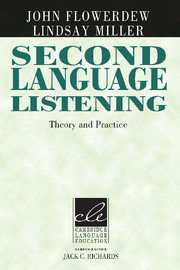Part I - HISTORICAL BACKGROUND
Published online by Cambridge University Press: 04 February 2010
Summary
In Part I of this book, we present the main theoretical aspects that have traditionally been considered when discussing how learners develop listening skills.We begin in Chapter 1 by outlining the main approaches and methods that have been used over the past 70 years or so to teach English in general, and then we comment on how listening has, or has not, been accommodated in each approach and method.
In Chapter 2,we describe current psycholinguistic models of the listening process. Most approaches to teaching listening in the past have been influenced by three models – the so-called bottom-up, top-down, and interactive models. These models are still important, and we maintain that knowledge of how they operate is essential to understanding how an approach to the teaching of listening may be developed.
The main approaches to listening are influenced by our knowledge of the different types of meaning involved in understanding spoken text and how they affect the ways in which we listen to messages. These elements are reviewed in Chapter 3.
Chapter 4 takes the reader one stage deeper in the process of understanding the particular features of spoken text and how these features play a prominent role in any model that tries to account for howwe listen. Attention is given to both monologue and, important for us, dialogue.
If learners are to develop skills in manipulating the features and elements of listening, they need to be aware of their specific learning styles and strategies and how these can affect the way they listen to spoken text. This is the theme of Chapter 5, the last chapter of Part I.
- Type
- Chapter
- Information
- Second Language ListeningTheory and Practice, pp. 1 - 2Publisher: Cambridge University PressPrint publication year: 2005



